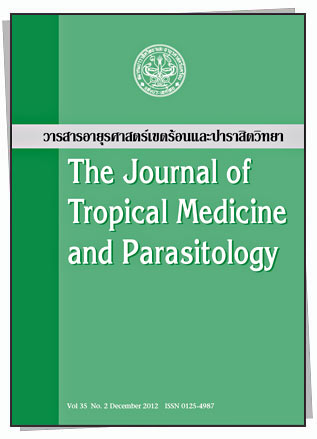Prevalence of Intestinal Parasitic Infections in Villagers and Teachers in Mahasarakham Province
Main Article Content
Abstract
Abstract
Intestinal parasitic infections remain a serious public-health problem in Thailand. Most infectionsresult from fecal-oral transmission by ingestion of contaminated water and food, the major vehiclesfor transmitting infection. This study examined the prevalence of intestinal parasitic infections in435 stool samples (villagers living in Ban Nong Um = 177, villagers living in Ban Khawao Yai = 98, andteachers living in Amphoe Mueang = 160) in Mahasarakham Province, by formalin-ether concentrationtechnique. The overall prevalence of intestinal parasitic infections in the 435 stool samples was14.71% (64/435). The highest prevalence was found among villagers living in Ban Khawao Yaiwith an infection rate of 30.60%, compared with 12.99% and 6.88% among villagers living in BanNong Um and teachers in Amphoe Mueang, respectively. Strongyloides stercoralis infection (6.44%) wasthe most frequent pathogenic intestinal parasitic infection, followed by Opisthorchis viverrini (5.74%)and Taenia sp (1.61%), respectively. Moreover, the prevalence of intestinal parasitic infections inBan Nong Um and Ban Khawao Yai was significantly higher than among teachers (19.27% vs 6.88%,p < 0.001). In conclusion, instruction in personnel hygiene and appropriate health education onthe prevention of parasitic infections should be provided to the population, to reduce parasiticinfections in the study area.
Keywords: prevalence; intestinal parasitic infection; formalin-ether concentration technique; villagers; Mahasarakham; Thailand

